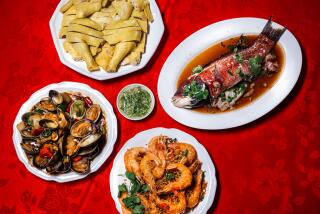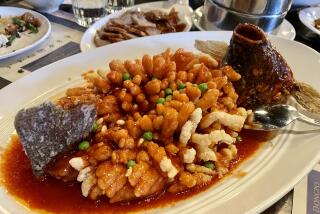The Other Millennia
- Share via
Enough of Y2K. What were people eating in Y1K?
Well, we have only one actual cookbook from around the year 1000, a collection of recipes from the court of 9th century Baghdad. It turns out that the caliph and his buddies were eating a lot of tandoori roasted meats, stewed lamb dishes perfumed with spices and rose water and sweetmeats made from ground nuts. The hippest dish was roast meat served with a sweet pudding (ju^dha^ba) that had been cooked under the meat to catch its drippings. Baghdad’s favorite pastry was essentially marzipan wrapped in a paper-thin crepe.
The Chinese were already cooking much as they do today, but the Indian cookery of a thousand years ago would look a little unfamiliar because most of the dishes on a present-day Indian menu were imported later by Muslim conquerors. Still you’d recognize it as Indian by the spices. Tenth century Europe was hosting several barbarian invasions and didn’t bother writing any cookbooks, but we can assume its food was rather plain.
A thousand years earlier, in Y0K, the Romans were eating lots of fish and pork, often in baked dishes of mixed ingredients bound with eggs (patina) or crumbled bread (minutal). Some of their sausages were stuffed with brains. Chinese cooking was quite different from today’s: The staple grain was millet instead of rice and stir-frying was unknown. The preferred dishes were stews (geng) of meat, vegetables and often grain.
The further back we go, the fewer the details we have on the food, so when it comes to Y-minus-1K, we’re pretty sketchy. We do know that 500 years earlier, around 1500 BC, the Babylonians were apparently stewing everything in beer, like some bachelors we know today.
More to Read
Eat your way across L.A.
Get our weekly Tasting Notes newsletter for reviews, news and more.
You may occasionally receive promotional content from the Los Angeles Times.










